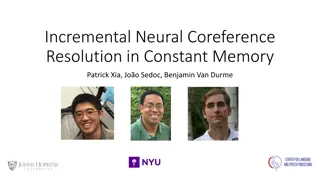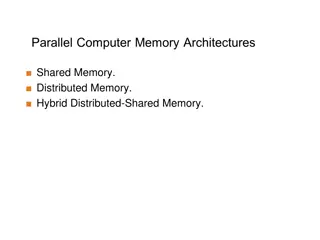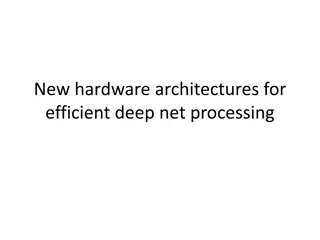Overcoming Memory Constraints in Deep Neural Network Design
Limited availability of high bandwidth on-device memory presents a challenge in exploring new architectures for deep neural networks. Memory constraints have been identified as a bottleneck in state-of-the-art models. Various strategies such as Tensor Rematerialization, Bottleneck Activations, and Gradient Checkpointing have been proposed to address these limitations. Static planning is deemed unnecessary, and Dynamic Tensor Rematerialization through Gradient Checkpointing offers a practical solution by creating a Tensor Level Cache that optimizes compute-memory tradeoffs without the need for static information. This approach allows for on-the-fly rematerialization, optimizing memory usage efficiently.
Download Presentation

Please find below an Image/Link to download the presentation.
The content on the website is provided AS IS for your information and personal use only. It may not be sold, licensed, or shared on other websites without obtaining consent from the author.If you encounter any issues during the download, it is possible that the publisher has removed the file from their server.
You are allowed to download the files provided on this website for personal or commercial use, subject to the condition that they are used lawfully. All files are the property of their respective owners.
The content on the website is provided AS IS for your information and personal use only. It may not be sold, licensed, or shared on other websites without obtaining consent from the author.
E N D
Presentation Transcript
Dynamic Tensor Dynamic Tensor Rematerialization Rematerialization Presenter: Marisa Kirisame* Steven Lyubomirsky* Altan Haan* Jennifer Brennan Mike He Jared Roesch Tianqi Chen Zachary Tatlock *Equal contribution
The limited availability of high bandwidth on-device memory creates a memory wall that stifles exploration of novel architectures. Across applications, authors of state- of-the-art models cite memory as a limiting factor in deep neural network (DNN) design. Jain et al., Checkmate: Breaking the Memory Wall With Optimal Tensor Rematerialization (2020) 2
The Bottleneck: Activations Sohoni et al., Low-Memory Neural Network Training: A Technical Report (2019) 3
Checkpointing: Trade Time for Space Recompute activations instead of storing them Gradient Checkpointing, Chen et al. (2016) Pick segments to recompute in backward pass O( ?) memory for ? ? extra ops Many later segmenting approaches Checkmate, Jain et al. (2020) Rematerialize individual values ILP for optimal(!) planning 4
Static Planning is Unnecessary Past approaches plan checkpoints in advance Require static knowledge of the model Does not fit the eager execution framework Planning can be expensive, limits applications Our contributions: Static planning is unnecessary for checkpointing Still achieve good compute-memory tradeoffs 5
Dynamic Tensor Rematerialization Gradient Checkpointing is a Tensor Level Cache! A simple cache on top of the runtime system Greedily allocate, evict and recompute as needed No static information necessary Can be easily implemented in all kind of framework Decoupled from automatic differentiation Trivially usable on higher order gradient Can also be used without autodiff (e.g. Island Algorithm) Very general, still competitive with static planning! 6
Rematerializing on the Fly Pin: Needed right now Circles: Tensors t2 t4 t6 t7 t0 t1 t3 t5 MEMORY BUDGET: 4 = IN MEMORY Arrows: Dependencies Current operation: PerformOp(op7, [t5, t6]) 7
Rematerializing on the Fly t2 t4 t6 t7 Problem: Need to compute t7 but t5 is evicted t0 t1 t3 t5 MEMORY BUDGET: 4 = IN MEMORY Current operation: Rematerialize(t5) 8
Rematerializing on the Fly t3 is present, but no room for result t2 t4 t6 t7 t0 t1 t3 t5 MEMORY BUDGET: 4 = IN MEMORY Current operation: PerformOp(op5, [t3]) 9
Rematerializing on the Fly The heuristic is free to pick t2 t2 t4 t6 t7 t0 t1 t3 t5 MEMORY BUDGET: 4 = IN MEMORY Current operation: PerformEviction() 10
Rematerializing on the Fly t2 t4 t6 t7 Now we can recompute t5 t0 t1 t3 t5 MEMORY BUDGET: 4 = IN MEMORY Current operation: AllocateBuffer(t5.size); op5(t3) 11
Rematerializing on the Fly Our arguments are back but still no room for t7! t2 t4 t6 t7 t0 t1 t3 t5 MEMORY BUDGET: 4 = IN MEMORY Current operation: AllocateBuffer(t7.size) 12
Rematerializing on the Fly t2 t4 t6 t7 Don t need t3 right now, so we can evict t0 t1 t3 t5 MEMORY BUDGET: 4 = IN MEMORY Current operation: PerformEviction() 13
Rematerializing on the Fly Now we can proceed t2 t4 t6 t7 t0 t1 t3 t5 MEMORY BUDGET: 4 = IN MEMORY Current operation: op7(t5, t6) 14
Rematerializing on the Fly t2 t4 t6 t7 t0 t1 t3 t5 MEMORY BUDGET: 4 = IN MEMORY 15
DTR in Pictures Reduced (compute Reduced (compute- -memory), memory), ? ? memory (n=128 layers) memory (n=128 layers) Begin Backprop 16
DTR in Pictures Reduced (compute Reduced (compute- -memory), memory), ? ? memory (n=128 layers) memory (n=128 layers) Begin Backprop Horizontal lines: Checkpoints! Triangles: Recomputing segments 17
DTR In Pictures 80 layers 128 layers 200 layers 18
DTR in Pictures O(log N) memory in O(n log N) time! 19
DTR: Just Some Callbacks AllocateBuffer(size): : Allocate if enough room, else evict until there is PerformEviction(): : Heuristic chooses a tensor to evict Rematerialize(t): : Recompute t by replaying its parent op (PerformOp) PerformOp(op, args): : Rematerialize evicted arguments Make room for result and compute it Update metadata 20
What Do Heuristics Look Like? Dynamic prediction of which tensor is least valuable Useful metadata, easy to track: Cost ?(?): Avoid recomputing expensive tensors Staleness ? ? : Recently used likely to be used soon Memory ? ? : Large tensors are most profitable to evict Resulting policy: minimize ? = ?(?)/(? ? ? ? ) 21
Comparison Against Static Techniques Simulated comparison via the Checkmate MLSys 2020 artifact 22
Pseudocode // Evict until enough memory. function AllocateBuffer(size): while size > AvailableMemory(): PerformEviction() return RawAllocate(size) function PerformOp(op, args): exclude args from eviction for arg in args: Rematerialize(arg) update arg s last access time buf = AllocateBuffer(out_size) res = store op(args) into buf allow eviction for args again update bookkeeping for res return res function PerformEviction(): free tensor with smallest score function Rematerialize(t): if t has been evicted: PerformOp(t.op, t.args) 23
Reasoning About Tensor Cost True cost of a rematerialization includes recursive calls Recursively computing exact cost is expensive! We approximate evicted components via union-find Each equivalent class denote a evicted neighborhood Neighbor = parent/child in the computation graph Maintain a compute cost for each evicted neighborhood When a tensor is evicted, join the equivalent class with its evicted neighbor When tensor rematerialized, map to a new component Leaves phantom connections but is fast 24
Equivalence Class via Union Find Given a finite set of element: Can merge two set into one Can check if two element in one set Can keep information on each finite set Merge(1, 2) Merge(2, 5) Merge(6, 8) Merge(3, 4) Merge(5, 6) 25
Evicted Neighborhood example t2 t4 t6 t7 t0 t1 t3 t5 {t1, t2, t4} in one evicted neighborhood (cost = 3) {t5, t7} in one evicted neighborhood (cost = 2) 26
Further Prototype Optimizations Eager Eviction: evict tensors with no external references Three optimizations to speed up eviction search Ignoring small tensors (<1% of average size) Random sampling (visit square root of size of total pool) Batch eviction: search for min cost, then evict all tensor < 2x min cost Considerably reduces overhead of DTR Danger of excluding tensor needed to meet budget! 27
DTR as a compiler pass Suppose static graph Run dtr once, record all eviction/rematerialization Generate a new graph based on the recording Known as staging: move compute from runtime to compile time Remove all search overhead at runtime Can now use further compiler pass to do more optimization Inspired by MegEngine s implementation 28
Prototype Implementation in PyTorch Pytorch support many different kinds of Tensor GPU, CPU, Dense, Sparse, Quantified Autodiff and Dynamic Batching also implemented as Tensor! The core of pytorch dispatch operators into their implementation Checkpointing Is implemented as a Tensor CheckpointTensor wrap a Tensor and Its operator Only maintain metadata and make eviction decision 29
Prototype Implementation in PyTorch One Line!!! 30
Prototype Implementation in PyTorch Thin wrapper over tensor operators, core logic a few hundred LOC 31
Conclusion Train bigger networks on smaller GPUs Useful both as a runtime cache, and as a compiler pass Model parallelism: use fewer GPUs, cheaper Implemented by the Megengine team, upstreaming to pytorch Read the paper and see our prototype: https://github.com/uwsampl/dtr-prototype Happy to answer questions about implementation! marisa@cs.utah.edu 32























